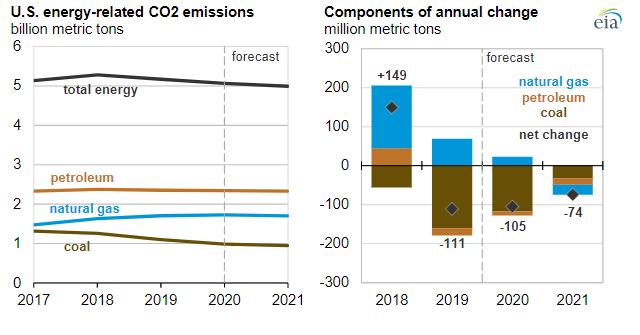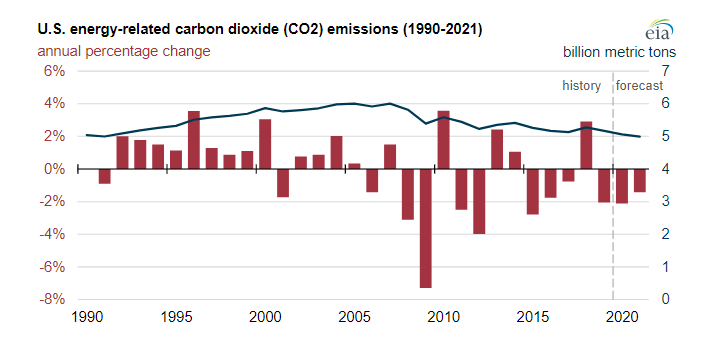The US Energy Information Administration (EIA) forecasts year-over-year decreases in energy-related carbon dioxide (CO2) emissions through 2021. After decreasing by 2.1% in 2019, energy-related CO2 emissions will decrease by 2.0% in 2020 and again by 1.5% in 2021 for a third consecutive year of declines, EIA forecasts in its Short Term Energy Outlook.
These declines come after an increase in 2018 when weather-related factors caused energy-related CO2 emissions to rise 2.9%.
If this forecast holds, energy-related CO2 emissions will have declined in 7 of the 10 years from 2012 to 2021. With the forecast declines, the 2021 level of fewer than 5 billion metric tons would be the first time emissions have been at that level since 1991.
After a slight decline in 2019, EIA expects petroleum-related CO2 emissions to be flat in 2020 and decline slightly in 2021.
The transportation sector uses more than two-thirds of total US petroleum consumption.
Vehicle miles traveled (VMT) grows nearly 1% annually during the forecast period.
In the short term, increases in VMT are largely offset by increases in vehicle efficiency.
Meanwhile, natural gas-related CO2 increased by 4.2% in 2019, and EIA expects that it will rise 1.4% in 2020.
However, EIA expects a 1.7% decline in natural gas-related CO2 in 2021 because of warmer winter weather and less demand for natural gas for heating.
Changes in the relative prices of coal and natural gas can cause fuel switching in the electric power sector.
Small price changes can yield relatively large shifts in generation shares between coal and natural gas.
EIA expects coal-related CO2 will decline by 10.8% in 2020 after declining by 12.7% in 2019 because of low natural gas prices.
It also expects the rate of the coal-related CO2 decline to be less in 2021 at 2.7%.
The declines in CO2 emissions are driven by two factors that continue from recent historical trends.
EIA expects that less carbon intensive and more efficient natural gas-fired generation will replace coal-fired generation and that generation from renewable energy—especially wind and solar—will increase.

As total generation declines during the forecast period, increases in renewable generation decrease the share of fossil-fueled generation.
EIA estimates that coal and natural gas electric generation combined, which had a 63% share of generation in 2018, fell to 62% in 2019 and will drop to 59% in 2020 and 58% in 2021.
Coal-fired generation alone has fallen from 28% in 2018 to 24% in 2019 and will fall further to 21% in 2020 and 2021.
The natural gas-fired generation share rises from 37% in 2019 to 38% in 2020, but it declines to 37% in 2021.
In general, when the share of natural gas increases relative to coal, the carbon intensity of electricity supply decreases. Increasing the share of renewable generation further decreases the carbon intensity.




























































